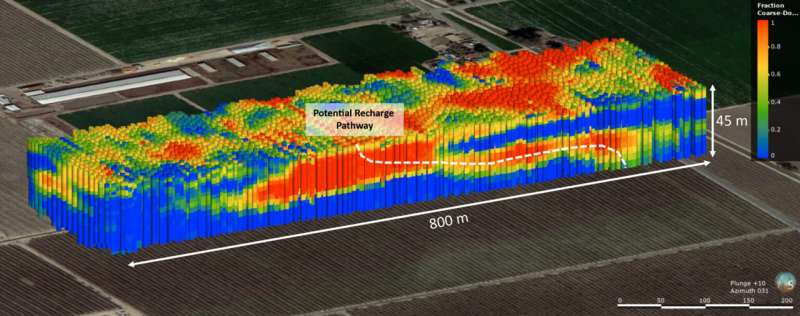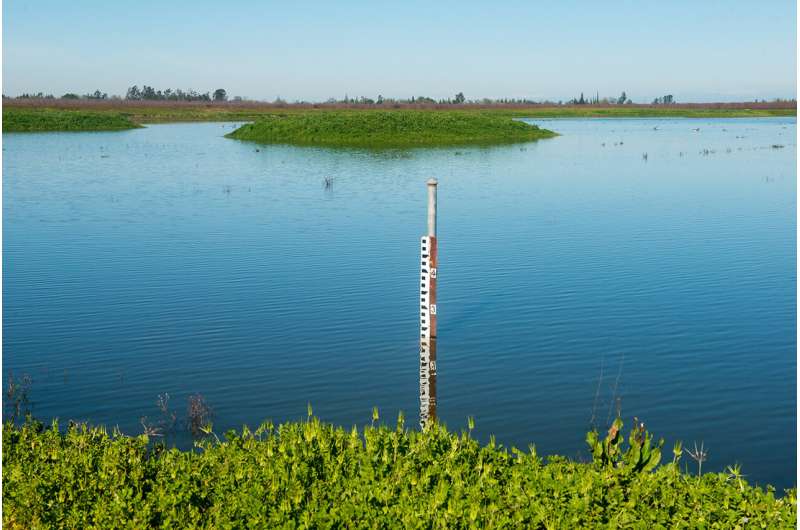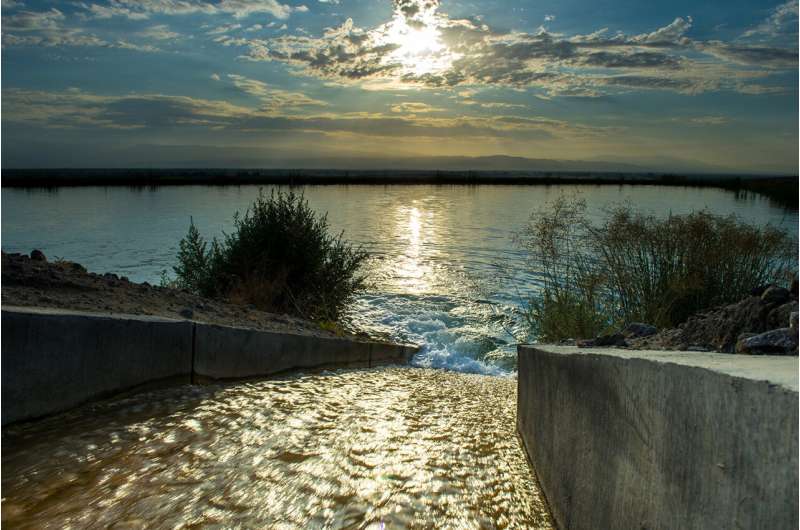Finding the 'sweet spots' for managed aquifer recharge

Much of California's $50 billion agricultural industry depends on groundwater. We typically see only what this water makes possible above the soil: almond and pistachio groves, citrus orchards, rows of lettuce and grapevines and cattle herds in a valley that supplies a quarter of the nation's food even when surface water is scarce.
But a lot is happening below the surface. Deep underground, intricate channels of sand and gravel weave through tightly packed clays and silts, allowing Earth to hold water like a sponge.
Excessive pumping can squeeze out the sponge, permanently depleting an aquifer's storage capacity and releasing toxic arsenic into water supplies. In California's fertile Central Valley, years of rampant overdraft have led to shortages in many low-income, predominantly Latino communities and caused wells to go dry and the land surface to sink, damaging infrastructure.
"For the longest time, management of our groundwater systems was neglected," said Stanford University geophysicist Rosemary Knight. "People didn't really understand what was happening and didn't recognize the need for careful management."
Hidden structures
Amid a rapidly worsening drought and a California mandate to bring aquifer withdrawals and deposits into balance by 2040, there's now growing urgency to better understand the hidden structures of groundwater basins.

One possible solution to balancing the aquifer water budget involves strategically flooding a field, orchard or dedicated recharge pond and letting the water seep down through sandy channels. In research published earlier this month in Vadose Zone Journal, Knight and postdoctoral scholar Meredith Goebel demonstrate a new way to assess sites for this type of managed aquifer recharge using soil measurements and a geophysical system towed by an all-terrain vehicle.
The geophysical system relies on a process similar to medical imaging of the body and involves probing the subsurface down to a depth of 200 feet with a magnetic field. This produces a measure of electrical resistivity, which tends to be higher in sands and gravels than in clays that can block water from reaching aquifers. Next, the same swath of land is surveyed using a method known as cone penetrometer testing, in which technicians push a sensor-laden steel cone 70 feet or so into the ground in several places around the site to determine sediment types.
Armed with both datasets, Knight and Goebel show how to mathematically transform the resistivity measurements into sediment type, effectively providing the keys to unlock a 3D map of what lies beneath potential recharge sites. "This provides a way for water managers to assess land before they commit to the expense of acquiring it and putting in place a recharge operation," said Knight, the George L. Harrington Professor in Stanford's School of Earth, Energy & Environmental Sciences (Stanford Earth).
Goebel says now is the time to build these maps. "For a lot of these recharge operations in the Central Valley, they're talking about trying to capture the floodwaters during wet years. They've got to do a lot of legwork now to be ready when the water comes," she said.
It could also help assuage growers' concerns about flooding their land, Knight added. "The last thing we want is to flood a field and lose a lot of that water through evaporation. Or even worse, have water-logged soil that damages the tree roots in an almond orchard or increases the risk of the trees blowing over," said Knight who is also a senior fellow at the Stanford Woods Institute for the Environment.

Worsening drought
The research comes as drought once again intensifies across California and the West, with about 87 percent of the region now experiencing some level of drought and most California counties facing extreme drought conditions or worse. Worldwide, recent research suggests up to one in five wells globally are at risk of drying up if groundwater levels decline by even a few meters. "Sustainable management of our groundwater resources is essential to support both human needs and the functioning of natural ecosystems," Knight said. "We can't keep pumping groundwater to the point that streams no longer flow and fish no longer spawn."
Knight has long worked to expand airborne electromagnetic surveys of groundwater systems in California, and this summer the state water agency is scheduled to begin a $12 million project mapping groundwater basins throughout California by interpreting data acquired by a transmitter loop suspended from a helicopter—an approach that Knight helped to refine for application in California through her leadership of a two-year pilot project.
The new method brings the airborne system down to Earth, transmitting electromagnetic signals from a device—developed over the past five years at Denmark's Aarhus University—that happens to fit neatly between rows of almond trees. Knight and Goebel worked with an almond grower and regional water managers to send the system bouncing along on a trailer towed by an all-terrain vehicle through a grove in California's Tulare County, which is now almost entirely in a state of "extreme drought."
Long term, Knight envisions groundwater recharge figuring into zoning. "If there's a development proposal for an area, this new system could be used to assess the area in terms of its contribution to recharging the groundwater system," she said. "If it turns out that, hey, this is one of those sweet spots with pathways for recharge, you shouldn't think of paving it. Or, if you do think about development in that area, you do it in such a way as to maximize the protection of its role in recharge."
More information: Meredith Goebel et al, Recharge site assessment through the integration of surface geophysics and cone penetrometer testing, Vadose Zone Journal (2021). DOI: 10.1002/vzj2.20131
Provided by Stanford University





















